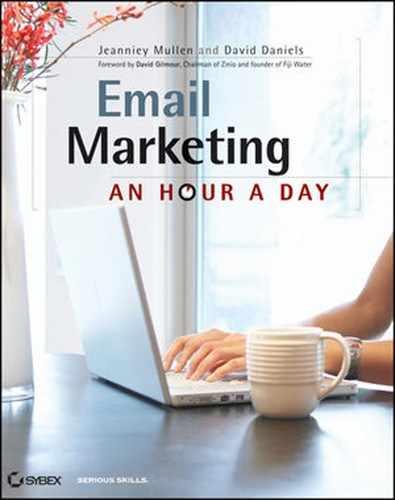0%
20Chapters
0-1Hours read
0kTotal Words
Book Description
If the idea of starting an email marketing campaign overwhelms you, the authors of Email Marketing: An Hour a Day will introduce you to email marketing basics, demonstrate how to manage details and describe how you can track and measure results. Case studies, step-by-step guides, checklists, quizzes and hands-on tutorials will help you execute an email marketing campaign in just one hour a day. When you feel comfortable with the basics, learn how to use video and audio enabled email, implement tools like mobile devices and leverage social networks.
Table of Contents
- Copyright
- Advance Praise for Email Marketing: An Hour a Day
- Dear Reader,
- Acknowledgments
- About the Authors
- Foreword
- Introduction
- 1. Understanding Email Marketing Today
- 2. The Five Critical Elements of Every Email You Create
- 3. Getting Ready to Build Your Email Marketing Efforts
- 4. What Happens Once You Send Your Email
- 5. Eight Key Drivers of Your Email Campaign
- 5.1. Key Driver 1: Email Address Acquisition
- 5.2. Key Driver 2: Creative/Copy
- 5.3. Key Driver 3: Making the Data Work
- 5.4. Key Driver 4: Multichannel Integration
- 5.5. Key Driver 5: Technology (Delivery, Deployment, and Design)
- 5.6. Key Driver 6: Reporting/Analytics
- 5.7. Key Driver 7: Privacy/Governmental Control
- 5.8. Key Driver 8: Reactivation
- 5.9. Test Your Knowledge
- 6. Preparing Your Email Marketing Strategy
- 6.1. Week 1: Preparing Your Resource Arsenal
- 6.1.1. Monday: Getting Smart (the Seven Essential Truths About Email Marketing)
- 6.1.1.1. Truth 1: Email Has Evolved into a Cornerstone of Our Lives
- 6.1.1.2. Truth 2: Email Marketing Best Practices Change, All the Time
- 6.1.1.3. Truth 3: Any Type of Messaging Done Electronically Is Email Marketing
- 6.1.1.4. Truth 4: Email Addresses Mean Money; Don't Ignore Your Non-responders
- 6.1.1.5. Truth 5: This Is Not "The Farmer in the Dell"
- 6.1.1.6. Truth 6: Technology Partners Often Act Like Military Members
- 6.1.1.7. Truth 7: Ignore the Rules (Except the Law)
- 6.1.2. Tuesday: Evaluating Tools and Resources
- 6.1.3. Wednesday: Budgeting
- 6.1.4. Thursday: Related Marketing Initiatives
- 6.1.5. Friday: Getting the Boss to Sign the Check
- 6.1.1. Monday: Getting Smart (the Seven Essential Truths About Email Marketing)
- 6.2. Week 2: Building the Blueprint for Success
- 6.2.1. Monday: Evaluating Your Current House File and File Size Needs
- 6.2.2. Tuesday: Creating the Acquisition Plans
- 6.2.3. Wednesday: Focusing on the Opt-In Process and Customer Preference Centers
- 6.2.4. Thursday: Reviewing the Opt-Out Process
- 6.2.5. Friday: Making Sure Your Landing Pages Are a Good Place to Land
- 6.3. Week 3: Counting Down to "Go Time"
- 6.4. Week 4: Testing Your Way to the First Campaign
- 6.5. Test Your Knowledge
- 6.1. Week 1: Preparing Your Resource Arsenal
- 7. Month 2: Ensuring Success as You Launch Your Campaign
- 7.1. Week 1: Sending Your First Campaign
- 7.2. Week 2: Creating a Plan to Optimize Your Results
- 7.3. Week 3: Measuring Email's Impact on Other Channels
- 7.3.1. Monday: Measuring the Role of Email in a Customer's Purchase
- 7.3.2. Tuesday: Determining the Value of Your Email Addresses and Campaigns
- 7.3.3. Wednesday: Increasing Email Sending Costs to Improve Top-Line Results
- 7.3.4. Thursday: Exploring Web Analytics and Email Integration
- 7.3.5. Friday: Finding and Targeting Your Advocates
- 7.4. Week 4: Promoting Your Email Results Within Your Organization
- 7.5. Test Your Knowledge
- 8. Month 3: Adding Bells and Whistles
- 8.1. Week 1: Using Email as a Feedback Tool
- 8.2. Week 2: Creating Video- and Audio-Enabled Emails
- 8.2.1. Monday: Deciding Whether Using Audio or Video Is Right for Your Emails
- 8.2.2. Tuesday: Building the Five Layered Emails
- 8.2.3. Wednesday: Making Your Video Email Viral
- 8.2.4. Thursday: Making Your Video Email an Integrated Part of a Larger Campaign
- 8.2.5. Friday: Allowing Your Reader to Create Their Own Video Email
- 8.3. Week 3: Creating Mobile Email
- 8.3.1. Monday: Why Your Email Needs to be Mobile
- 8.3.2. Tuesday: The Mobile Email Creative
- 8.3.3. Wednesday: How Many Readers in Your Database Are Reading "on the Run"?
- 8.3.4. Thursday: Defining Your Mobile Email Preference Center
- 8.3.5. Friday: Making Your Current Email Strategy Work in a Mobile World
- 8.4. Week 4: Creating Social Email
- 8.5. Test Your Knowledge
- 9. Getting Ready for Year 2 and Beyond
- A. Vendor Resource List
- B. Email Checklists
- Glossary
- More Advance Praise for Email Marketing: An Hour a Day
